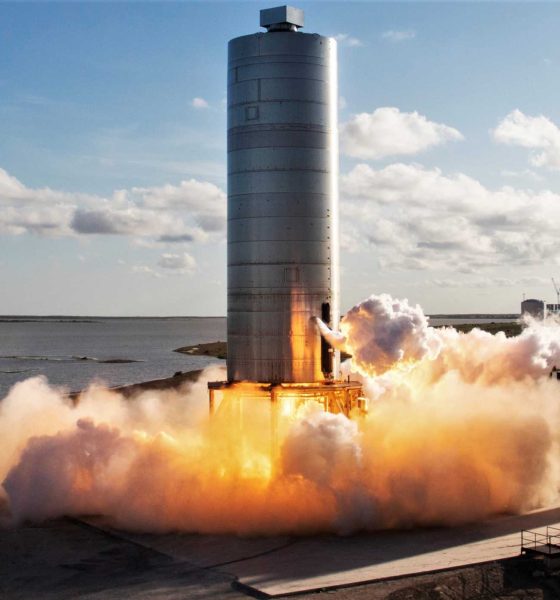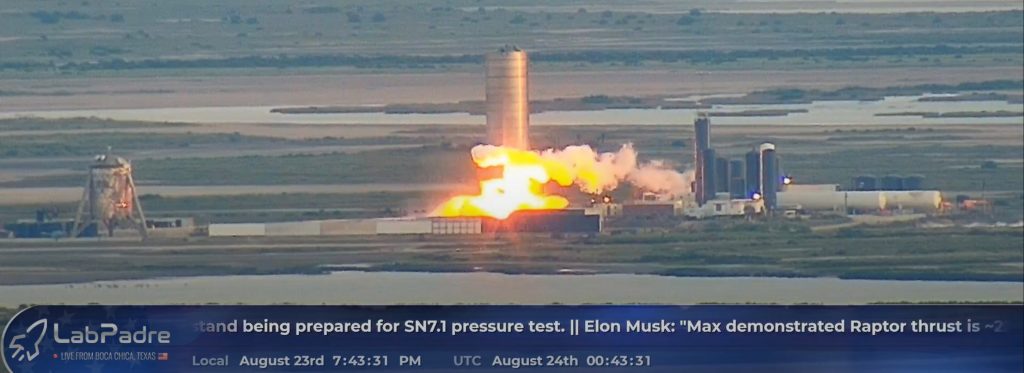

News
SpaceX’s second Starship hop imminent after Raptor static fire test
SpaceX has successfully fired up a new Starship prototype’s Raptor engine, putting the company on track for its second Starship hop test as soon as this week.
The milestone comes not long after SpaceX Starship serial number 6 (SN6) completed its first cryogenic proof, a pressure test with liquid nitrogen (LN2) used to safely verify the structural integrity of tanks (and rockets, in particular). Measuring 9m (30 ft) wide and some 30m (~100 ft) tall, SpaceX rolled Starship SN6 from its Boca Chica, Texas factory to a nearby test and launch facility on August 11th and wrapped up its first acceptance test on August 16th.
Now, just seven days after its cryo proof, SpaceX has installed a new Raptor engine (SN29), prepared SN6 for a much riskier round of tests, and completed a static fire with said engine, leaving just one major step between the Starship and its hop debut. Of course, the process still had its fair share of hiccups.
SpaceX’s first SN6 static fire test window – published by Cameron County in the form of road closure notices – was set for 8 am to 8 pm CDT (UTC-5), August 23rd a few days after the Starship’s cryo proof. The first test attempt began around 9:30 am but was aborted soon after as SpaceX employees returned to the launch pad to (presumably) troubleshoot. The second attempt began around 2:30 pm, leaving a little less than half the test window available.
Attempt #2 very nearly managed to extract a static fire, aborting possibly a second or less before Raptor ignition around 3:41 pm. Once again, SpaceX teams returned to the pad after Starship was detanked and safed, briefly inspecting the general location of the rocket’s Raptor engine before once again clearing the pad around 6:30 pm. At long last, Starship SN6 began a smooth and fast flow that culminated in the ignition of Raptor SN29 around 7:45 pm, just 15 minutes before the end of SpaceX’s test window.


As with all SpaceX static fires, engineers must still analyze the data produced – and possibly inspect pad or rocket hardware – to verify vehicle health before proceeding into launch operations. Unlike all other SpaceX static fires, the company doesn’t announce the results of those tests – nor the solidified launch window – during prototype development programs. In the context of iterative aerospace development, while there may be such a thing as a “good” or “bad” test, all tests – as long as they’re performed safely and produce a large quantity of usable data – are essentially successful.
As such, it’s likely for the best that SpaceX doesn’t put the public focus on the “success” of any given test. Still, it means that unofficial educated guesses are typically the only way to determine the results of any given test and how those results impact the next steps. For SN6, the very broad-strokes conclusions one can draw from unofficial livestreams suggest that the Starship’s first Raptor static fire was a success. Assuming that the unknown cause(s) of the day’s two prior aborts were minor and easily rectified, SpaceX is likely exactly on schedule for Starship SN6’s first hop attempt.
SN6’s first flight is expected to be an almost identical copy of Starship SN5’s highly successful August 4th debut, following the same 150m (~500 ft) parabolic trajectory. Filed before SN6’s August 23rd static fire, SpaceX has penciled in Friday, August 28th for Starship SN6’s own hop debut. Thanks to the fact that SpaceX was able to complete both SN6’s cryo proof and static fire on the first day of their respective test windows, August 28th is likely well within reach. Stay tuned for updates as Starship SN6’s hop debut schedule solidifies.
Check out Teslarati’s Marketplace! We offer Tesla accessories, including for the Tesla Cybertruck and Tesla Model 3.

News
Tesla starts showing how FSD will change lives in Europe
Local officials tested the system on narrow country roads and were impressed by FSD’s smooth, human-like driving, with some calling the service a game-changer for everyday life in areas that are far from urban centers.

Tesla has launched Europe’s first public shuttle service using Full Self-Driving (Supervised) in the rural Eifelkreis Bitburg-Prüm region of Germany, demonstrating how the technology can restore independence and mobility for people who struggle with limited transport options.
Local officials tested the system on narrow country roads and were impressed by FSD’s smooth, human-like driving, with some calling the service a game-changer for everyday life in areas that are far from urban centers.
Officials see real impact on rural residents
Arzfeld Mayor Johannes Kuhl and District Administrator Andreas Kruppert personally tested the Tesla shuttle service. This allowed them to see just how well FSD navigated winding lanes and rural roads confidently. Kruppert said, “Autonomous driving sounds like science fiction to many, but we simply see here that it works totally well in rural regions too.” Kuhl, for his part, also noted that FSD “feels like a very experienced driver.”
The pilot complements the area’s “Citizen Bus” program, which provides on-demand rides for elderly residents who can no longer drive themselves. Tesla Europe shared a video of a demonstration of the service, highlighting how FSD gives people their freedom back, even in places where public transport is not as prevalent.
What the Ministry for Economic Affairs and Transport says
Rhineland-Palatinate’s Minister Daniela Schmitt supported the project, praising the collaboration that made this “first of its kind in Europe” possible. As per the ministry, the rural rollout for the service shows FSD’s potential beyond major cities, and it delivers tangible benefits like grocery runs, doctor visits, and social connections for isolated residents.
“Reliable and flexible mobility is especially vital in rural areas. With the launch of a shuttle service using self-driving vehicles (FSD supervised) by Tesla in the Eifelkreis Bitburg-Prüm, an innovative pilot project is now getting underway that complements local community bus services. It is the first project of its kind in Europe.
“The result is a real gain for rural mobility: greater accessibility, more flexibility and tangible benefits for everyday life. A strong signal for innovation, cooperation and future-oriented mobility beyond urban centers,” the ministry wrote in a LinkedIn post.
News
Tesla China quietly posts Robotaxi-related job listing
Tesla China is currently seeking a Low Voltage Electrical Engineer to work on circuit board design for the company’s autonomous vehicles.

Tesla has posted a new job listing in Shanghai explicitly tied to its Robotaxi program, fueling speculation that the company is preparing to launch its dedicated autonomous ride-hailing service in China.
As noted in the listing, Tesla China is currently seeking a Low Voltage Electrical Engineer to work on circuit board design for the company’s autonomous vehicles.
Robotaxi-specific role
The listing, which was shared on social media platform X by industry watcher @tslaming, suggested that Tesla China is looking to fill the role urgently. The job listing itself specifically mentions that the person hired for the role will be working on the Low Voltage Hardware team, which would design the circuit boards that would serve as the nervous system of the Robotaxi.
Key tasks for the role, as indicated in the job listing, include collaboration with PCB layout, firmware, mechanical, program management, and validation teams, among other responsibilities. The role is based in Shanghai.
China Robotaxi launch
China represents a massive potential market for robotaxis, with its dense urban centers and supportive policies in select cities. Tesla has limited permission to roll out FSD in the country, though despite this, its vehicles have been hailed as among the best in the market when it comes to autonomous features. So far, at least, it appears that China supports Tesla’s FSD and Robotaxi rollout.
This was hinted at in November, when Tesla brought the Cybercab to the 8th China International Import Expo (CIIE) in Shanghai, marking the first time that the autonomous two-seater was brought to the Asia-Pacific region. The vehicle, despite not having a release date in China, received a significant amount of interest among the event’s attendees.
Elon Musk
Elon Musk and Tesla AI Director share insights after empty driver seat Robotaxi rides
The executives’ unoccupied tests hint at the rapid progress of Tesla’s unsupervised Robotaxi efforts.

Tesla CEO Elon Musk and AI Director Ashok Elluswamy celebrated Christmas Eve by sharing personal experiences with Robotaxi vehicles that had no safety monitor or occupant in the driver’s seat. Musk described the system’s “perfect driving” around Austin, while Elluswamy posted video from the back seat, calling it “an amazing experience.”
The executives’ unoccupied tests hint at the rapid progress of Tesla’s unsupervised Robotaxi efforts.
Elon and Ashok’s firsthand Robotaxi insights
Prior to Musk and the Tesla AI Director’s posts, sightings of unmanned Teslas navigating public roads were widely shared on social media. One such vehicle was spotted in Austin, Texas, which Elon Musk acknowleged by stating that “Testing is underway with no occupants in the car.”
Based on his Christmas Eve post, Musk seemed to have tested an unmanned Tesla himself. “A Tesla with no safety monitor in the car and me sitting in the passenger seat took me all around Austin on Sunday with perfect driving,” Musk wrote in his post.
Elluswamy responded with a 2-minute video showing himself in the rear of an unmanned Tesla. The video featured the vehicle’s empty front seats, as well as its smooth handling through real-world traffic. He captioned his video with the words, “It’s an amazing experience!”
Towards Unsupervised operations
During an xAI Hackathon earlier this month, Elon Musk mentioned that Tesla owed be removing Safety Monitors from its Robotaxis in Austin in just three weeks. “Unsupervised is pretty much solved at this point. So there will be Tesla Robotaxis operating in Austin with no one in them. Not even anyone in the passenger seat in about three weeks,” he said. Musk echoed similar estimates at the 2025 Annual Shareholder Meeting and the Q3 2025 earnings call.
Considering the insights that were posted Musk and Elluswamy, it does appear that Tesla is working hard towards operating its Robotaxis with no safety monitors. This is quite impressive considering that the service was launched just earlier this year.








